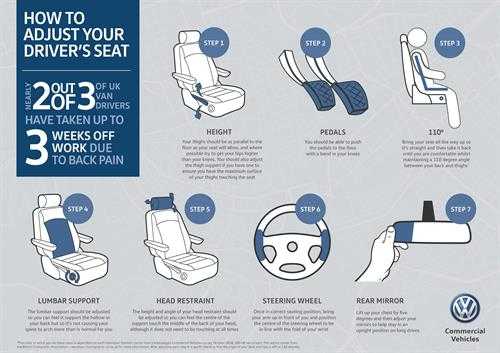
Van Driver Back Health
Are you looking after your health?
If you’re a van driver who’s currently spending more time on the road as a key worker, you may want to take note of research from Volkswagen Commercial Vehicles, which suggests you could be at risk of developing back problems.
Volkswagen partnered with the British Chiropractic Association (BCA) to survey 500 van drivers across the UK and found that an average 70 per cent of participants had often had to take as much as three weeks off work a year to recover from back problems.
See how much you can save
Compare van insurance quotes today!
Many delivery drivers and tradespeople who have been listed as ‘key workers’ are expected to work extended hours to ensure supplies and services are provided across the country, drastically increasing their average seven hours at the wheel.
However, whether you’re an essential worker or travelling from A to B for work, it’s still worth sitting up and paying attention. The research revealed that while half of van drivers say they adjust their seat to the correct position, two-thirds are still sitting incorrectly or missing crucial steps.
Among the most common mistakes were positioning the seat too close to the steering wheel and angling the seat too far back.
Prab Chandhok, chiropractor and BCA member, commented: “With an increase in the number of people supporting the national effort to provide essential deliveries and relay important supplies to organisations such as hospitals, supermarkets, food banks and pharmacies, it is very important drivers also consider their own health and wellbeing to be able to help more.
“Long hours spent in a vehicle can cause aches and pains, but there are simple steps individuals can take to better look after their back health when driving.”

Following the results of the survey, Volkswagen and BCA have compiled these top 10 tips to avoid back pain:
1. Get your height right Your thighs should be as parallel to the floor as possible and try to get your hips higher than your knees. You should also adjust the thigh support if you have one to ensure you have the maximum surface of your thighs touching the seat.
2. Employ some pedal power You should be able to push the pedals to the floor with a bend in your knees.
3. Stick to 110° Bring your seat all the way up so it’s straight and then take it back until you are comfortable whilst maintaining a 110-degree angle between your back and thighs.
4 .Lean on your lumbar support Only if required, the lumbar support should be adjusted so you can feel it support the hollow in your back but so it’s not causing your spine to arch more than is normal for you.
5. Get your head straight The height and angle of your head restraint should be adjusted so you can feel the centre of the support touch the middle of the back of your head, although it does not need to be touching at all times, as long as no more than 2cm away.
See how much you can save
Compare van insurance quotes today!
6. Take to the wheel Once in the correct seating position, bring your arm up in front of you and position the centre of the steering wheel to be in line with the fold of your wrist.
7. Check your rear mirror Lift up your chest by five degrees and then adjust your mirrors to help stay in an upright position on long drives.
8. Take a break It is crucial you take regular rest periods or at least mini breaks within each 45-60 minutes of sitting. This allows your body to adopt a new position by standing/moving and giving your tissues a break from becoming tight in a loaded sitting position.
9. Don’t forget to stretch Each time you stop, try to find a safe spot outside the vehicle to perform 5–10 knee bends by raising your knees past 90 degrees in front of you, allowing the leg muscles to stretch a little. If you don’t have any existing foot, ankle, knee or hip issues, try performing 3-5 simple squats, bending just below a seated position that is comfortable for you to get movement into your leg muscles. When you get home, you can also perform all of these exercises before relaxing.
10. Reach for some rescue remedies A warm bath or shower can help relax your muscles after a long day. Following that, if you still feel soreness, you can try a gel ice pack or even a bag of peas wrapped in a suitable cover and apply it in the area of soreness for 10–15 minutes.
